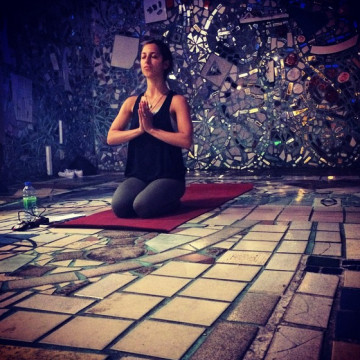Picture this: You’re in a yoga class doing chataranga number 100, or so it seems, when suddenly your teacher asks, “How can you take your practice off the mat and connect it to the rest of your life?” You might be thinking to yourself, “I guess I can go home, do wheel pose, take a picture, and then post it on my Instagram, right?”
If you’re anything like me when I first began my physical, or asana, yoga practice, I had no idea how to “take my yoga off the mat.” While asana can be a great workout for our bodies and give us a great sweat, it also allows us to become deeply intimate, honest, and close with ourselves. As I began to dig deeper into this idea, I started to view my physical practice as a self-study. And why not? Isn’t there this innate connection between our bodies and our minds? As a result, the way we practice on our mats reflects who we are and how we think, giving a whole new meaning to the term “body language.”
This self-study can be very important to your yoga practice. It can take you deeper in ways you never imagined possible. It can also be very important to your life “off the mat,” giving you the tools you need to be the best version of you possible, in your job, in your relationships, and to yourself.
Here are 5 ways you can begin your own self-study.
1. Acting vs. Reacting
Imagine you are in the same yoga class. Your teacher asks you to take Warrior II for the third time (if this is the case, your teacher might be me!) So you’re in Warrior II, and 30 seconds goes by, then one minute, then your leg begins to shake and burn, and you begin to think, “I CANT TAKE IT ANYMORE!” so you straighten your leg. This is what I call reacting on your mat: you straighten your leg because you feel discomfort and your instincts begin to kick in. But what if you went against that instinct, holding Warrior II for just 30 more seconds or until the teacher asks you to move into a different pose? This is what I call acting: you feel the burn, you want to straighten your leg, but you make the conscious decision not to. Those 30 seconds may not seem like much, but over time each of those seconds will add up allowing you to hold Warrior II for what seems like an eternity. So ask yourself, are you the one who acts or reacts? This often translates into our lives without us even noticing. Think of a difficult scenario in your life – maybe you were asked by your boss to redo a project for the third time, or you were rear-ended, or your dog pooped on your rug! Did you give in to instinct – did you act or re-act?
2. Letting Go of Your Ego
You are in yoga class, but this time you are not feeling your 100 percent. Let’s say you have a low back injury and it’s time for backbends. Normally, you are the back bending queen and you love that about your practice, but today you know that wheel pose is only going to make this injury worse. Do you opt for a supported bridge pose or do you take wheel because you don’t want to be the only one in class not doing this pose? In other words, do you listen to your body or does your ego get in the way?
Letting go of your ego can be very difficult in life. After all, we’re only human! Ego can manifest itself in many different ways, but has one common aspect – we are seeking something in the end. In the example above, you wanted to make sure everyone knew you could do the wheel. But is it really important that others know that you can do this pose with ease?
Let’s say you go to work one morning. The night before you argued with your sister about something and you can’t stop thinking about how you are right and she was wrong. You walk over to a colleague and start explaining the situation. As you’re retelling the story, you start looking for any indication that your colleague agrees with you and not your sister. In the end, the colleague might agree and he might disagree, but what is important to note here is that the ego was seeking satisfaction, or vindication – a feeling that was not fulfilled with your conversation with your sister. When we let our ego control our bodies in yoga, it can be hard to let go of the ego in other areas of our daily lives as well.
3. Drishti: Focus the Gaze, Focus the Mind
In yoga class, your teacher asks you to take Warrior I. You find your pose, feet rooted, arms lifted, and gazing straight ahead. While your teacher is assisting another student, you start looking down at your feet. Then it hits you – you have a pedicure appointment tomorrow morning! Your teacher then tells you to exhale as you move into Warrior II. Has this ever happened to you? In class you may have heard your teacher tell you to focus your gaze, or drishti. This is when you set your eyes on one spot to focus the breath, body, and mind. There’s a saying, “Where the eyes go, the body follows,” and this can be true in many other physical activities. If you’ve ever played basketball, you know how important it is to focus the eyes on where you are shooting and then follow through with the body. This is the same idea in yoga. So the minute you begin to let your eyes wander out of focus, the rest of you (breath, body and mind) drift out of this focus as well. As a result, you wind up losing out on the benefits of the pose.
In life, the focus can translate in many ways: perhaps a promotion at work, or running a half marathon, or decision to start living a healthier lifestyle. This kind of focus may be a bit trickier than just fixing your eyes on one spot, but you can learn so much from the discipline it takes to have that constant drishti throughout class (not just in one pose at a time). Discipline is the key word here – if losing a few pounds is what you’re after, you’re going to need to focus your “eyes on the prize”and find the discipline it takes to eat a few extra greens, or swap your French fries for carrot sticks. After a while, just as in yoga, this discipline takes less work and will come more naturally and with ease.
4. Comparison and Competition
Thinking about yoga as a self-study can make it easier to understand why teachers try to take comparing and competition out of the practice. If we are focusing on what others are doing in yoga class, how can we possibly understand what we are doing in this same class? Focusing on what others are doing can also take us back to the dreaded ego which can lead to injury (or making an injury worse).
In life, comparison and competition can be almost toxic. As humans in our Western society and in the age of social media, comparison and competition is easier than ever to get sucked into. Images of celebrity bikini bodies, men with chiseled faces, and women carrying the latest Chanel quilted handbag, can cause others to feel inadequate about themselves and how they look. I’ve heard some women (of all ages) say to me, “If only I had that (fill in the blank), then I’d be happy.” The truth, however, is that these external and temporary ideas of happiness are just that – temporary. If we constantly compare ourselves to others, then we will constantly be unhappy with ourselves. When we focus on ourselves and what truly is important to us, then we can find true happiness. Sure you may have a bad day here and there, but overall you’ll accept who you are as a person and you will stop defining your life by the bag that you carry. This leads us to the last self-study tip…
5. Authenticity
Authenticity comes from combining these tips of self-study to discover who you truly are at each present moment – your truth. Finding your truth takes a lot of reflection and time, which can be a very difficult thing to accomplish. Reflection means taking time to look at yourself in your practice going through the four steps above over and over, and each time being completely honest with yourself about what is happening. You might think that you are always honest with yourself, but the mind has many sneaky ways of tricking you into believing something that isn’t true. Let’s go back to the mat. You are in a beautiful crescent lunge and the teacher says to bend deeper into the front leg so that your knee is over your ankle. You begin to bend deeper noticing how hard the lunge is becoming. You stop at a point where you think you can’t bend anymore. Every time you come into this lunge from now on you go right to this point and stop. Over time you’ve told yourself this is as far as you can go, and over time your body begins to believe this as true.
Off the mat, you decide you want to start eating right and lose a little weight. Someone suggests keeping a food journal to help you stay accountable. You contemplate it, but think that it is pointless. The next day at work someone brings in some chocolate. You are a chocoholic wanting to have at least four pieces, but you hold out hoping others will eat the chocolate instead. Throughout the day, that chocolate is somehow still lingering around the office and you begin to think, “Okay, I’ll just have one piece instead.” (*Note: I personally don’t think having one piece of chocolate is bad, or two, or three…did I just eat a whole chocolate bar writing this?…) Anyway, you decide to eat that one piece of chocolate and are proud that you only had the one. Throughout the month, you have just a bite of this, or just a bite of that. Over time these little bites add up, but you believe that you have done well for yourself over the course of the month and forget all about those little bites. Then its weigh in time…you’ve only lost a pound?! How can that be? You did so well! Or did you? Your mind told you every day that you did so well, so over time you begin to believe it too.
Now, I’m not saying your lunge or your diet reflects who you are as a person – no single moment will ever define you. It is the decisions we make in each moment, over time, which help us to learn about our bodies, minds, and soul on and off the mat. So on the way home from your next yoga practice, grab a journal and begin jotting down some things you noticed throughout your practice. Ask yourself about your actions and reactions, your gaze and focus, your ego, and your attention. Also jot down how these observations made you feel, how they affected your mood, and how you feel overall about all of this. Overall, there may be some things you love about your practice, things you find rewarding and strong, but there may also be some things you don’t love so much and things you want to work on. In the end, you’ll discover your true self and you’ll never look back. Shine this light, shine this truth. Namaste!
Related: 10 Ways to Apply Yoga in Your Daily Life
7 Things Your Yoga Teacher Wishes You Knew
Photo: Marisa DeFrancesco






